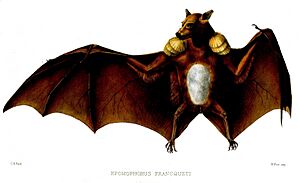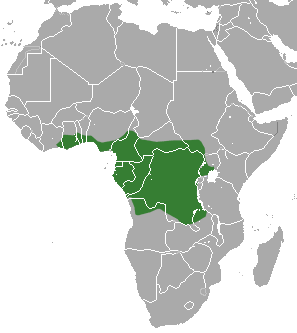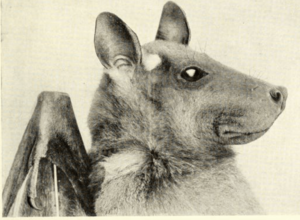Franquet's epauletted fruit bat facts for kids
Quick facts for kids Franquet's epauletted fruit bat |
|
|---|---|
 |
|
| Conservation status | |
| Scientific classification | |
| Genus: |
Epomops
|
| Species: |
franqueti
|
 |
|
| Franquet's epauletted fruit bat range | |
The Franquet's epauletted fruit bat (Epomops franqueti) is a type of large bat. It belongs to a group called megabats. This bat lives in many different places. You can find it from forests in Subsaharan Africa to tropical areas near the equator. It is one of three kinds of bats with special "epaulettes" on their shoulders.
Contents
Where Do Franquet's Bats Live?
Franquet's epauletted fruit bats live in many parts of Africa. Their home range stretches from Ivory Coast in the west to South Sudan in the east. They also live south into countries like Angola and Zambia. You can find them in countries such as Angola, Benin, Cameroon, and Ghana. They also live in Nigeria, Rwanda, Tanzania, and Uganda.
These bats like different kinds of natural homes. They live in warm, wet lowland forests. They can also be found in tropical swamps and dry savanna areas.
What Does a Franquet's Bat Look Like?
This bat was first described in 1860 by Robert Fisher Tomes. He named it Epomophorus francqueti after a Dr. Franquet. It is a brown bat with no tail. It has large white patches on its shoulders. These patches look like military "epaulettes." It also has white fur on its belly and white spots on its ears.
A Franquet's bat's head and body are about 16.5 to 18 centimeters (6.5 to 7.1 inches) long. Its forearm is about 7.4 to 10.2 centimeters (2.9 to 4.0 inches) long. Female bats weigh from 56 to 115 grams (2.0 to 4.1 ounces). Male bats are a bit heavier, weighing from 59 to 160 grams (2.1 to 5.6 ounces).
Male bats have special shoulder pouches. These pouches have glands that make chemicals. The white hair tufts, or epaulettes, help spread these chemicals. This helps the bats communicate using smells.
How Do Franquet's Bats Behave?
Adult male Franquet's bats have a strong voice box. They make a loud, high-pitched call at night. This call can last for several minutes. Close up, it sounds like "kyurnk." From far away, it sounds like a musical whistle. Franquet's bats, like many large fruit bats, cannot echolocate. This means they don't use sound echoes to find their way.
Males often sit in their favorite trees at night. They are usually about 100 meters (328 feet) apart. They call loudly and show off their epaulettes. When females are nearby, males call even more. One male was heard making 10,000 calls in just three hours! Their calls can be heard from a mile away.
Franquet's bats live in both forests and open areas. During the day, they rest in trees and bushes. They are very alert even when resting. They usually roost about 4 to 6 meters (13 to 20 feet) high. These bats are not very social. You will usually find them alone or in small groups of two or three.
Franquet's bats eat mainly at night. They feed on fruit, nectar, and flower petals. They make a lot of noise while they eat. These bats mostly suck the juice from their food. They don't chew it much. Their lips can stretch out to grab the fruit. They use their teeth to pierce the fruit's skin. Then, they squeeze the fruit with their jaws. Their tongue presses the fruit against the roof of their mouth. This helps them suck out the juice.
Sometimes, bats fill their cheek pouches with food. Then they fly to a safe spot to eat. They move the food from one cheek to another. They chew it with their sharp teeth and swallow the juices. After all the juice is gone, they spit out the leftover fibers. These look like small pellets. You can often see many of these pellets under trees where bats have been feeding.
Franquet's Bat Life Cycle and Reproduction
In Uganda, Franquet's bats have two breeding seasons each year. These seasons are timed so that babies are born during the two rainy seasons. The mother bat is pregnant for about five to six months. In the first breeding season, babies are born in September. In the second season, babies are born in late February. When they are born, young bats weigh about 20 grams (0.7 ounces). Similar breeding patterns have been seen in bats in Congo and Ivory Coast.
Conservation Status
Franquet's fruit bat is found in many places. It has a large population. It also lives in many protected areas. Because of this, it is listed as a species of "Least Concern." This means it is not currently at risk of disappearing. The species can adapt to different environments. So, no special conservation efforts are needed right now.



